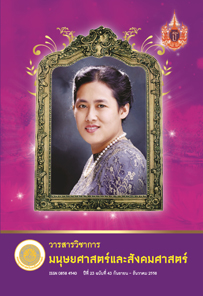จากสมัยใหม่ (Modernism) สู่หลังสมัยใหม่ (Postmodernism): การขับเคลื่อนทางวัฒนธรรมสู่ศิลปะกับธรรมชาติ From Modernism to Postmodernism: The Driven Path of Culture to Art and Nature
Main Article Content
Abstract
บทความนี้ นำเสนอมโนทัศน์หลักและความเปลี่ยนแปลงจากโลกสมัยใหม่สู่สภาวะหลังสมัยใหม่ของตะวันตก จากคริสต์ศตวรรษที่ 19 วิธีคิดแบบสังคมอุตสาหกรรมในยุคสมัยใหม่ซึ่งมีรากฐานคิดจากมนุษยนิยมได้ส่งผลต่อการเปลี่ยนแปลงอย่างรวดเร็วต่อสังคม วิถีชีวิต วัฒนธรรมและการสร้างสรรค์ทางศิลปกรรมเพื่อตอบรับความต้องการของมนุษย์แบบมวลผลิต จนกระทั่งผ่านพ้นมาถึงช่วงหลังสมัยใหม่ในคริสต์ศตวรรษที่ 20 กับมโนทัศน์ที่พลิกผันสู่การให้คุณค่ากับอดีต มรดกทางวัฒนธรรมและสิ่งแวดล้อม มโนทัศน์แบบหลังสมัยใหม่คำนึงถึงความหลากหลายและสิ่งต่าง ๆ รอบตัวที่ต้องอยู่อาศัยอย่างพึ่งพิง โดยมนุษย์มิได้ตัดขาดจากอดีตหรือแยกตนเองออกมาอย่างเอกเทศ แต่เป็นส่วนหนึ่งในการผสานศาสตร์ สรรพความคิด และสรรพสิ่งเข้าสู่ความสัมพันธ์แบบเป็นองค์รวม ซึ่งความผันแปรทางความคิดและวัฒนธรรมได้ถูกบันทึกและถ่ายทอดออกสู่ผลงานศิลปกรรม
This article presents the concept and the changing of Modern andPostmodern notion in western world. From the 19th century, the notion of industrial society which based on Humanism concept had changed the environment, lifestyle, cultural and artistic creativity dramatically. This is to meet with human needs for mass production in modern world. Until the arrival of the Postmodernity in the 20th century with the returning to the valueof the past, cultural heritage and nature, a postmodern conception is to valuediversity and things with its interdisciplinary. A man is not separated fromtheir past neither nor stand alone independently. A man is a part of theblending of knowledge, thoughts and things as a whole. The changing ofnotion and culture is written and conveyed through the arts.
Downloads
Download data is not yet available.
Article Details
Section
Articles
บทความทุกบทความเป็นลิขสิทธิ์ของวารสารวิชาการมนุษยศาสตร์และสังคมศาสตร์ มหาวิทยาลัยบูรพาเท่านั้น


